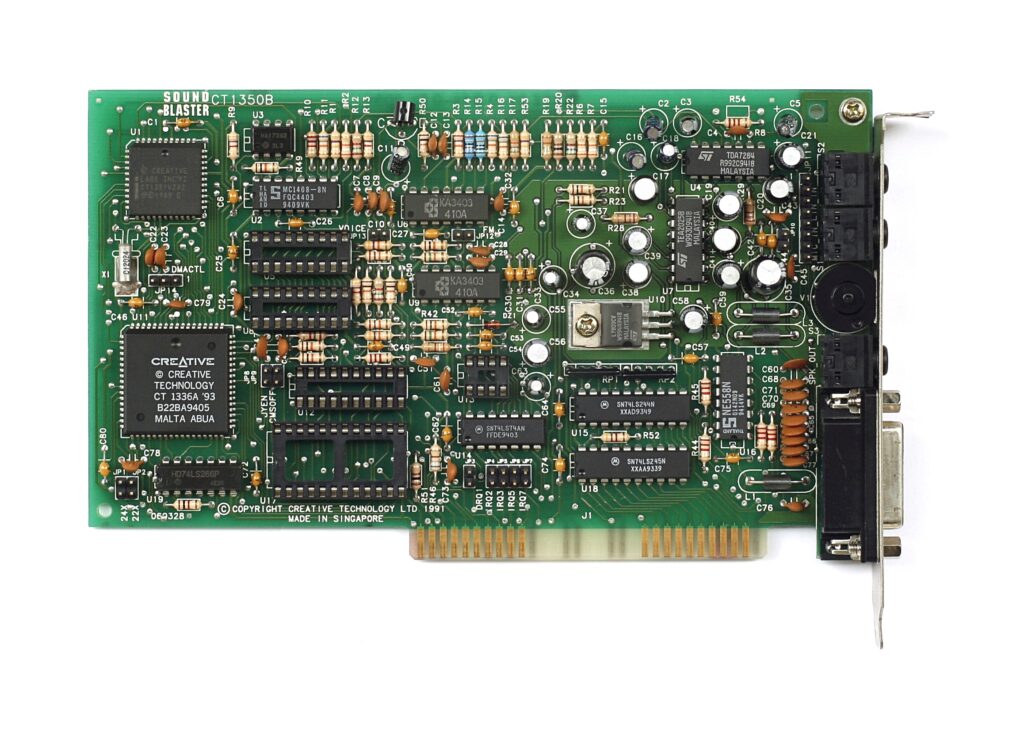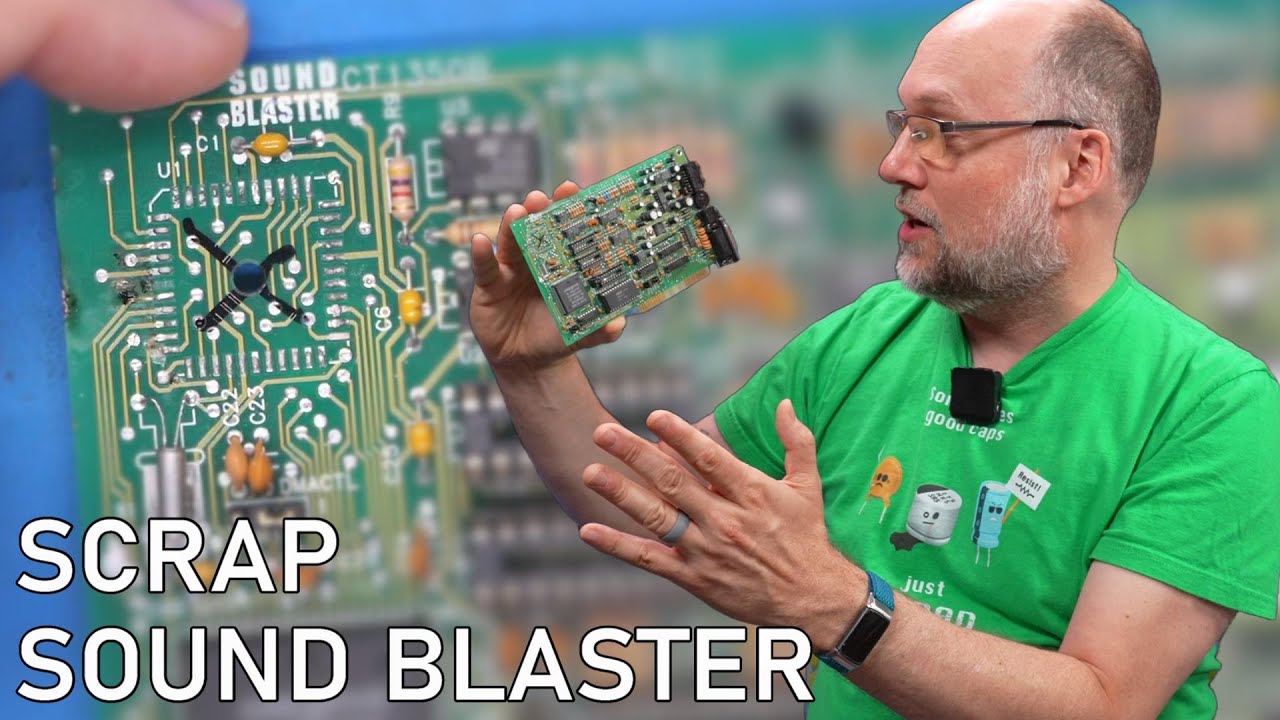In retro-computing, where every board is equal parts memory and archaeology, few badges spark as much nostalgia as Sound Blaster. That’s why the latest “miracle” on Adrian’s Digital Basement —the YouTube channel of repair wizard Adrian Black— spread so quickly: a Sound Blaster 2.0 (CT1350B) from 1994, fished out of a scrap pile, is playing again after some precise surgery and a dash of 3D printing.
The card didn’t look promising: it had been “beheaded,” with a key IC ripped off and several pads and traces mangled. The good news: the essentials were intact —the Creative CT1336A (DSP/codec bridge) and the iconic Yamaha YM3812 (OPL2) FM chip that defined the sound of countless MS-DOS games.
The diagnosis: “just” a missing 8051 brain… and a few destroyed traces
Step one was identifying the missing chip. With help from Alex of the Bits und Bolts channel and a reverse-engineered schematic of the CT1350, Adrian confirmed the absent component was an Atmel MCU based on the Intel 8051 —the card’s “brain” for housekeeping. Better yet, drop-in replacements exist, and Alex supplied a couple pre-flashed with the right firmware.
Before fitting anything, Adrian bench-tested the card: the OPL2 still sang —pure AdLib-compatible FM without digitals— which was a great sign. Then came the delicate part: soldering the MCU back in while rebuilding lifted pads and broken traces from the earlier “extraction.” Cue fine tip, tiny bodge wires, patience, and that familiar mix of tension and satisfaction when the last joint cools. The reverse-engineered schematic proved “super helpful” to decide which damaged pads were critical and which weren’t.
Spoiler: after a slightly awkward solder session —and after turning up the card’s volume wheel (it was set to zero!)— full Sound Blaster functionality returned.
One after-hours detail: the card also lacked its slot I/O bracket. Maker fix: model and 3D-print a replacement, and the build was complete.
Why this 2.0 matters (and why collectors chase it)
The CT1350 was the final revision of the 8-bit ISA Sound Blaster. The CT1350B —Adrian’s card— preserved a valuable quirk: compatibility with C/MS (Creative Music System, an option on early SBs) alongside OPL2 FM and the DSP for digital audio. In practice, it unified the PC audio ecosystem in the early ’90s:
- Music via OPL2 FM (AdLib compatible).
- Digital effects via the Creative DSP.
- Optionally, C/MS as a third flavor.
Key 2.0 upgrades over the original SB included 44.1 kHz mono playback (8-bit, with that familiar noise floor) and, crucially, DMA (Direct Memory Access). The latter was a quiet revolution: before DMA, the CPU had to shovel audio data to the card by hand, a performance hit you could feel in games. DMA offloaded the work, letting titles that supported it deliver smoother frame rates with crisper effects. For many, the switch to digital audio was a shock: “I didn’t know PCs could do that.”
The short history: the card that standardized PC gaming audio
By the early ’90s, AdLib (FM-only) ruled PC music, and the Roland MT-32 dazzled with lifelike MIDI —if you had the cash. Sound Blaster fused the “accessible” best of both: AdLib-compatible FM music plus real sampled sound via the DSP, at a reasonable price. Two cards in one —three if you added C/MS. Result: Sound Blaster became the de facto standard every developer supported.
The 2.0 was that formula’s 8-bit peak. It remains desirable because it works with an enormous library of DOS titles, it sounds “right,” and it smells like youth to many: Doom, Pinball Dreams, and endless nights in Fast Tracker, Scream/Impulse Tracker…
The best of retro: community, documentation, and steady hands
Adrian’s repair underscores a few truths:
- Community matters: without help from Bits und Bolts, the reverse-engineered schematic, and pre-flashed MCUs, this would have been far harder —or a non-starter.
- Documentation saves hardware: publicly shared reverse schematics let us resurrect boards that would otherwise become e-waste.
- Makers close the loop: missing I/O bracket? Design and print one.
It’s also a reminder of how repairable that era’s hardware was: fat traces, a mix of through-hole and simple SMD, analog volume knobs, and discrete logic where today you’d see firmware and self-test. If you want to fix it —and dare to— you often can.
The video: electronics repair ASMR with a happy ending
In “Reviving a scrapped Sound Blaster 2.0 (CT1350B)”, Adrian walks through the debug, chip ID, solder and patchwork, and the final test with OPL2 FM plus digital. At times it’s ASMR for tinkerers: fine-tip iron, just-enough solder, tiny jumpers, and that “eureka” when the scope and your ears agree it’s alive. The volume-at-zero moment adds a human chuckle.
Why this matters beyond nostalgia
Yes, retro is fun. But it’s also technology conservation and a chance to teach the craft —measuring, tracing, understanding architectures— we’ll still need tomorrow. Saving a Sound Blaster 2.0 won’t change the world, but it preserves know-how and reminds us that making things last is often the smartest hack of all.
Bonus: it brings back that 8-bit, slightly hissy soundtrack that, for a generation, sounded like the future.
FAQ
Which exact model was restored?
A Creative Sound Blaster 2.0 CT1350B dated 1994 —the last 8-bit ISA revision to retain C/MS compatibility alongside OPL2 FM and DSP digital audio.
What was missing and how was it replaced?
A ripped-off Atmel 8051-class MCU. With help from Bits und Bolts, Adrian sourced pre-flashed replacements. After rebuilding pads/traces and soldering the MCU, full Sound Blaster functionality returned.
What makes the Sound Blaster 2.0 special vs. the original?
It added 44.1 kHz mono playback and, more importantly, DMA, cutting CPU overhead and enabling smoother gameplay where supported —all while keeping OPL2 FM (AdLib-compatible) and optional C/MS.
Where can I watch the repair?
On Adrian’s Digital Basement: Reviving a scrapped Sound Blaster 2.0 (CT1350B). The video covers diagnosis, soldering, testing, and a 3D-printed I/O bracket to finish the card.


